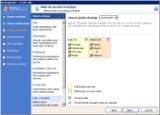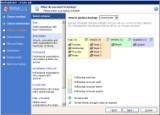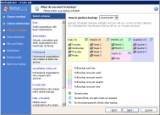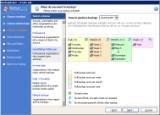An introduction to data backup tape rotation schemes
Learn about the different types of data backup tape rotation schemes to determine which one is best for your environment.
There are many different components data backup administrators must consider while working with tape storage in their data backup environment. And one of the most important decisions that a data backup administrator must make is which tape rotation scheme to use. The tape rotation scheme affects the number of tapes that an organization uses, and how long data is retained. This article examines several common tape rotation schemes.
Keep in mind that most of the tape rotation schemes discussed here are geared primarily toward full data backups. They can, however, be adapted to incremental and differential backups.
Round Robin
The most basic tape rotation method is called Round Robin. This idea behind this scheme is that the backup administrator decides how long tapes should be retained, and then uses a separate backup tape for each day within the retention period. For example, if an administrator wanted to retain tapes for one week, then the rotation scheme would require seven tapes (one for each day of the week). The tapes are used in sequence and each tape is overwritten with new data after a week.
N Week Daily
The Round Robin scheme is extremely simple, but it does not provide an option for long-term archived data. To get around this problem, some smaller organizations use a tape rotation scheme known as N Week Daily. N Week Daily is essentially the same as Round Robin, but the technique allows data to be retained for multiple weeks (the number of weeks is represented by N).
The problem with this technique is that it requires a lot of tapes. If you look at Figure A below, you can see just how many tapes are required. In this particular example, five tapes are required per week for every week of the rotation scheme. If the rotation scheme were to be four weeks long, then 20 tapes would be required. The other problem with this rotation scheme is that it does not allow for data archiving beyond the rotation period.
Figure A: N Week Daily tape rotation scheme

N Week Daily is an extended version of Round Robin.
Daily + N Weekly
The Daily + N Weekly scheme is similar to N Week Daily, but it doesn't require as many tapes. The basic idea behind this scheme is that a one week tape rotation cycle is used. What makes this scheme different from Round Robin, is that one tape is removed from the rotation cycle each week, thus yielding a weekly backup. These weekly backup tapes are retained for a specific number (N) of weeks, and are then placed back into the tape rotation scheme so that they can be recycled. An example of this rotation scheme is illustrated in Figure B.
Figure B: Daily + N Weekly backup scheme

The Daily + N Weekly backup scheme yields a weekly backup, and doesn't require as many tapes as N Week Daily.
Round Robin with archiving
The biggest problem with the Round Robin variations is that none of them support long-term data retention, which is very important to have in a data backup plan. To see why this is important, imagine that an organization uses a four-week tape rotation scheme. Now suppose that an organization finds that a critical file has been corrupted. If the corruption occurred more than four weeks ago, then there are no good copies of the file that can be retrieved from backup. For this reason, most of the organizations that use Round Robin also use data archiving.
There are several different variations of this technique, but they all build on the concept used by Daily + N Weekly. As was the case with Daily + N Weekly, tapes are periodically removed from the rotation scheme so that they will not be overwritten. Depending on the desired retention period, the organization will hold more than just weekly backup tapes. For example, one out of every four weekly backup tapes might be held as a monthly backup. One out of every three monthly backups might be held as a quarterly backup. These tapes might eventually be placed back into the rotation scheme, or they might be archived indefinitely, depending on an organization's needs.
Figure C illustrates an example of the rotation scheme that is designed to produce daily, weekly, monthly, and quarterly backups. Figure D shows the same rotation scheme adapted to also produce an annual backup.
Figure C: Rotation scheme for daily, weekly, monthly, and quarterly backups

This is how Round Robin works when quarterly archives are needed.
Figure D: Round Robin rotation scheme

This is how Round Robin can be adapted to produce annual archives.
Grandfather Father Son
Perhaps the best known tape rotation scheme is known as Grandfather Father Son (GFS). GFS is similar to the Round Robin with Archiving rotation scheme, but it is not quite as complicated. In GFS, the first tape of the week is held as a weekly backup. Weekly backups are held for five weeks. Four of the weekly tapes are placed back into the rotation scheme, but one of the tapes is held as a monthly backup. At the end on the year, the last monthly backup tape is permanently archived as an annual backup. GFS is illustrated in Figure E.
Figure E: Grandfather Father Son tape rotation scheme

Grandfather Father Son is probably the most popular tape rotation scheme.
Tower of Hanoi
The Tower of Hanoi tape rotation scheme is more complex than any of the other schemes described here. However, it yields archives that are more evenly distributed. Tower of Hanoi is a recursive backup method, and the length of the rotation period is based on the number of tapes that are used. The minimum number of tapes supported is three. Each additional tape used in the rotation cycle doubles the number of days in the cycle. For example, a four tape rotation extends the cycle to 16 days, and a five tape rotation extends the cycle to 32 days.
The three charts below illustrate how Tower of Hanoi works:
Tower of Hanoi with three tapes
Day 1: Tape 1
Day 2: Tape 2
Day 3: Tape 1
Day 4: Tape 3
Day 5: Tape 1
Day 6: Tape 2
Day 7: Tape 1
Day 8: Tape 3
Tower of Hanoi with four tapes
Day 1: Tape 1
Day 2: Tape 2
Day 3: Tape 1
Day 4: Tape 3
Day 5: Tape 1
Day 6: Tape 2
Day 7: Tape 1
Day 8: Tape 4
Day 9: Tape 1
Day 10: Tape 2
Day 11: Tape 1
Day 12: Tape 3
Day 13: Tape 1
Day 14: Tape 2
Day 15: Tape 1
Day 16: Tape 4
Tower of Hanoi with five tapes
Day 1: Tape 1
Day 2: Tape 2
Day 3: Tape 1
Day 4: Tape 3
Day 5: Tape 1
Day 6: Tape 2
Day 7: Tape 1
Day 8: Tape 4
Day 9: Tape 1
Day 10: Tape 2
Day 11: Tape 1
Day 12: Tape 3
Day 13: Tape 1
Day 14: Tape 2
Day 15: Tape 1
Day 16: Tape 5
Day 17: Tape 1
Day 18: Tape 2
Day 19: Tape 1
Day 20: Tape 3
Day 21: Tape 1
Day 22: Tape 2
Day 23: Tape 1
Day 24: Tape 4
Day 25: Tape 1
Day 26: Tape 2
Day 27: Tape 1
Day 28: Tape 3
Day 29: Tape 1
Day 30: Tape 2
Day 31: Tape 1
Day 32: Tape 5
As you can see, the lower numbered tapes get used far more frequently than higher numbered tapes. This means that the Tower of Hanoi scheme won't retain daily backups for a week like the other tape rotation schemes, but it does give you exponential retention periods. For example, in the five tape rotation scheme, Tape 1 is used 16 times (every other day). Tape 2 is used eight times (every four days). Tape 3 is used four times (with seven days in between). Tapes four and five are each used twice. In essence, this gives you daily and monthly backups like the other tape rotation schemes do, but you use far fewer tapes in the long run.
The downside to the Tower of Hanoi tape rotation scheme is its complexity and the fact that not all backup applications support it. This method also has a tendency to wear out lower numbered tapes because they are used so much more frequently than higher numbered tapes.
In the end, there is no one single backup tape rotation scheme that is clearly superior. Each tape data backup scheme has inherent advantages and disadvantages. It is ultimately up to you to choose the scheme that is the best fit for your organization's needs.
About the author: Brien M. Posey, MCSE, has previously received Microsoft's MVP award for Exchange Server, Windows Server and Internet Information Server (IIS). Brien has served as CIO for a nationwide chain of hospitals and was once responsible for the Department of Information Management at Fort Knox. You can visit Brien's personal website at www.brienposey.com.








